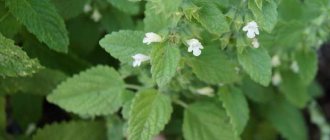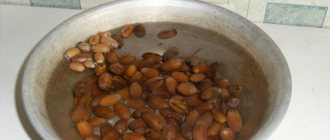06/12/201908/13/2019 Irina Malinina 0 comments
If you have an old and unsightly fence on your property, then perennial mallow can “hide” and “camouflage” it! The majestic and proud beauty is very unpretentious and unpretentious. If it grows with your neighbors, then often you don’t even need to plant it specially - it “comes to visit” itself and grows slender and blooming profusely. And you yourself won’t want to part with it - it’s hard to resist such beauty, because, like any coquette, the mallow can boast of the varied colors of its lush outfits.
Well, if you are unlucky and she has passed your yard, then “invite” her yourself, and we will now tell you in detail how to care for the beautiful Malvina.
Perennial mallow - botanical description
Photo: https://pixabay.com/photos/mallow-visitors-hummel-2465995/
Mallow, mallow, marshmallow, stockrose - all this is one name for a tall plant belonging to the Malvaceae family, except that the latter belongs to a different genus, but there are differences between they are insignificant. Mallow is widespread in tropical and temperate climates, and in our country this candle flower is found on the plot of almost every gardener.
What does Malvina (mallow) look like? This is a perennial, reaching a height of up to two meters. The trunk is straight, powerful, pubescent in “youth”, later – bare. The leaves are large, “spreading”. The root system is well branched, the roots are long, taprooted, and go deep into the ground.
Many women and girls can remember how they made dolls in childhood, using an upside-down mallow flower as a fluffy dress. And the head was attached from unopened buds - so the doll was ready in evening dress.
The corolla consists of five rounded fused petals; there are many stamens, they are attached to the corolla and form a tube. The flowers are located in the axils of the leaves and can be of different shapes, sizes and shades, since the plant has many varieties and varieties. Color varies from white to almost black. Flowers bloom from bottom to top, flowering begins in July and continues until early autumn.
In central Russia, mallow is grown as a biennial. In the first year a rosette of leaves appears, and in the second year a tall peduncle appears. But in the southern regions the plant can grow and bloom in the same place for three to five years.
This is a self-seeding flower; it reproduces well on its own. Seeds can also be collected by hand and sown before winter, or seedlings can be grown in the spring and planted in May.
Mallow is used in cooking and medicine. Its leaves are added to salads and soups, and its seeds taste like cheese and are used as a savory seasoning. Decoctions and infusions help with respiratory diseases, especially with a dry and barking cough. If your throat hurts or there are diseases of the oral cavity, then rinsing will quickly eliminate the problem. Mallow was often used to treat the digestive system. And externally, it is used to treat skin diseases and make sitz baths for hemorrhoids.
The plant has an enveloping, anti-inflammatory, bronchodilator and mild laxative effect. However, you should not self-medicate; in any case, all the necessary medications should be prescribed to you by a doctor.
A little about the stock rose
Mallow grows up to 1.5 meters, it depends on the plant variety. Flowers can also be of different sizes - from 5 to 15 cm in diameter, and of varying degrees of terry. Flowering is abundant, long-lasting, begins in July and ends in September. From the flowers, fruits are formed in the form of boxes containing seeds.
Perennial mallow, the planting and care of which will be described in the article, does not bloom in the first year after planting. Throughout this entire period, the plant devotes all its energy to growth and the formation of root rosettes. From the second year of life, perennial mallow (short or tall, it doesn’t matter) begins to bloom profusely, and then every year it pleases gardeners with beautiful flowers.
Popular types and varieties of mallow
Rose hollyhock, or rose mallow (Alcea rosea)
Photo: https://pixabay.com/photos/stock-rose-alcea-rosea-althaea-rosea-8487/ It looks very impressive if planted in a group.
It reaches a height of 2-2.5 meters. But the color scheme can be not only pink, but also white, yellow, red, lilac and even violet. There is practically no aroma. A striking representative is the terry variety Pleniflora Chaters. It is distinguished by its varied colors and “fluffy” multi-layered flowers.
Rose wrinkled stock (Alcea rugosa)
Grows up to one and a half to two meters, frost-resistant. The leaf blades are wrinkled and the petals are corrugated. The color of the flowers is all shades of yellow.
Musk mallow (Malva moschata)
Photo: https://www.pexels.com/photo/macro-photography-of-malva-flower-584387/
It has a specific musk aroma. It is used not only as an ornamental plant, but also as a medicinal plant. Low-growing species - no more than one meter. The diameter of the flowers is up to five centimeters, but they are located very densely on the peduncle, forming a lush blooming “column”.
Wood mallow (Malva sylvestris)
Photo: https://pixabay.com/photos/wild-mallow-flower-blossom-bloom-592262/
Also used to treat many diseases. It contains many mucous components that have an enveloping effect on the gastrointestinal tract and also have an anti-inflammatory effect in diseases of the respiratory system. If you brew wild mallow flowers, you can get a dark red drink reminiscent of hibiscus. However, the latter is prepared from the petals of the Sudanese rose (hibiscus), and it also belongs to the Malvaceae family.
Small flowers of different colors. Unfortunately, the species is mainly grown as an annual plant, since it is too heat-loving and does not survive in our winters.
The Zebrina variety looks very decorative, blooming with pink flowers with dark purple stripes.
Hybrid species
When crossing the above-mentioned species, many hybrids and variety groups of various colors appeared.
- Majorette Mixed. They do not exceed 75 cm in height, the flowers are semi-double with jagged petals, like a carnation.
- Chater's Double. Tall group (up to two meters). Double flowers with wavy petals are large in size and incredibly lush.
- Halo. The flowers are simple, but in the center of each of them there is a bright contrasting spot, similar to radiance, which is how the group got its name.
- Nigra. Recently, this is a very popular variety, since the petals are almost black in color and look very original among the bright variety.
- Creme de Cassis. Semi-double flowers in all shades of purple.
- Pleniflora. Lush terry color of a delicate yellow-cream shade.
- Peach'n'Dreams. Peach-colored ruffled petals.
Beneficial properties of mallow
In many countries it is known how beneficial this plant is for health. Various infusions are made from flowers and leaves for inflammation of the gastrointestinal tract. It is also included in the breast collection. Decoctions of flowers are used for compresses or lotions for skin diseases. Mallow has anti-inflammatory, emollient, expectorant and many other effects.
Absolutely all components of the mallow are used:
- seeds;
- root;
- leaves;
- flowers.
Crushed seeds are added to tea and coffee. In many countries, the seeds are added to food as a seasoning. A decoction is made from the root, which can be used internally for bronchitis and pneumonia, and also as compresses. Also, the leaves from which an infusion is made are effective for colds and bronchitis. For 200 grams of warm water, 20 grams of crushed leaves. Let it brew for 2 hours and take twice a day.
By soaking the leaves and flowers of mallow, you can obtain a wonderful, medicinal extract. This extract contains various vitamins that help relieve swelling and have a restorative effect on the skin. Various gels used in cosmetology are also made from this plant. Balms, refreshing shower gels, makeup removers, shampoos for children.
Tea using mallow has a positive effect on the digestive system. Useful properties help in the fight against diarrhea. For inflammation of the oral cavity, this tea will have an anti-inflammatory effect. Drinking this tea when you have a severe cough has a thinning effect and helps remove phlegm from the lungs. In this case, you can add a spoonful of honey.
Planting and care in open ground
Mallow is a very unpretentious flower, so it does not require special care, except perhaps only cosmetic care - trimming faded peduncles and gartering from the wind. But first things first!
Planting seeds
Depending on the climatic region, in March-April, mallow seeds are planted as seedlings.
Since germination often leaves much to be desired, many people use the “boiling water” method, when after planting the seeds, the substrate is watered with boiling water. Oddly enough, such a “shake” has a beneficial effect on the seed material, and sprouts quickly hatch from it. Be sure to cover the containers with film or glass to create a greenhouse effect!
After two true leaves have grown, the mallow should be transplanted into a deeper container, since its root is a taproot and occupies a larger area. Otherwise it will bend. Moreover, if several seedlings grow nearby at once, the root systems are intertwined, and it can be difficult to “untangle” them.
Seedlings should be planted as early as possible, around May, as soon as the soil finally warms up and while the seedlings are young. Older plants do not tolerate transplantation and may “get sick” and not adapt to new conditions.
Since perennial mallow does not like transplants, it is better to sow the seeds immediately at a permanent “place of residence” in the open ground. Or initially sow it in special peat pots that do not require the plants to be removed before planting.
Prepare a bed next to natural supports - fences or fences. Select an initially sunny and windless place; do not forget that the mallow will grow tall “candle” and may break or lie on the ground during bad weather.
Loosen the soil well, make furrows and pour boiling water over them (this is not necessary, but this unusual method is good for faster seed germination). Sow the seeds at a short distance from each other, thirty to forty centimeters between them will be enough. If you did not use the “boiling water” method, then water the bed with settled water from a watering can. In ten days the first shoots will appear.
Typically, hollyhocks grown from seeds bloom the following year. There are varieties that bloom already at the end of summer, but they are not sown immediately in open ground, but are grown using seedlings.
Soil Features
Perennial mallow prefers light, permeable soils with a neutral or slightly acidic reaction. Of course, if you fertilize the soil with organic or mineral fertilizers before planting, the plants will grow more powerful, stronger and will delight you with abundant flowering with large, bright flowers.
Heavy clay soil is not desirable for mallow, although it can grow anywhere. It is not recommended to plant flowers in lowlands, where melt water accumulates and high humidity remains after rains - excessively wet soil will lead to diseases and rotting of the root system.
Humidity and watering
Photo: https://www.pexels.com/photo/watering-plants-with-a-watering-can-6442/
You need to water the mallow so that there is no stagnation of water. It often grows naturally, without any care, and usually feels great. Many even consider it a weed, even though it blooms beautifully, since it can be difficult to “get rid” of it. Mallow does not need regular watering, but beautiful varietal species are still less persistent than wild ones, so they periodically require moderate watering.
Once a week, five liters for each plant - this is the norm for soil moisture in extreme heat. Do not forget that mallow is a child of the tropics, which means it does not easily tolerate drought.
Temperature and lighting
Mallow is a perennial unpretentious plant, but it will bloom more luxuriantly if it is grown in sunny areas protected from the wind.
At the same time, it exists effortlessly at a wide range of temperatures, easily tolerates drought and frost, but it can no longer handle severe frosts. However, breeders are not wasting time and are developing new frost-resistant varieties.
Garter
The mallow flower feels best next to a support - fences, fences, gazebos, walls of buildings. It is recommended to plant them in a cluster, next to each other. In this case, the flowers can easily be tied to natural supports.
If the perennial mallow grows in an open area, then on a windy day, storm, or thunderstorm, it can lie on the ground, bend over, or even break. To prevent this from happening, it is tied to specially driven pegs, between which twine is stretched.
It happens that side shoots appear, on which the plant spends energy and nutrition. When the soil is poor, excess branches can be broken off, but this is usually not done. Mallow is unpretentious and does not suffer from lack of feeding.
This plant does not require crown formation or pruning.
Fertilizer application
“Fatty” and fertile soil does not require fertilizing; rather, it will only do harm - flowers with excess fertilizer “grow fat” and increase the foliage mass more than they delight with their flowering.
If the soil is “poor”, then when planting mallow, be sure to add compost, humus, rotted manure or bird droppings to the holes. A week before flowering, it is advisable to feed the plant with a mineral complex fertilizer.
Preparing for landing
Selecting a location
When planting mallow, it is important to take into account its lighting preferences when choosing sunny locations. Although it can grow in shaded areas, you need to keep in mind that the flowering of the plant will be much poorer.
You should choose places for planting mallow that are not blown by strong winds. Since plants of this species are often quite tall, strong air gusts can break them. In addition, the wind can harm the delicate petals of flowers, as well as the tops of the plants on which the inflorescences are located.
Advice! It must be taken into account that transplants are harmful for mallow, as its root system has many branches and is easily damaged when removed from the soil. This explains the importance of initially choosing the right permanent location for planting the plant.
The soil
Mallow prefers light soil that allows moisture and air to pass through well. If a plant is forced to be planted in infertile soil, it should be fertilized regularly and in a timely manner.
mallow , or rose hollyhock, develops best in loamy soil that contains clay and sand in significant quantities. However, to protect the roots from becoming soaked, any soil should be provided with good drainage.
Reproduction methods
Photo: https://pixabay.com/photos/garden-spade-soil-gardening-work-1176406/
You need to know that growing mallow with seeds almost always deprives the flower of its varietal properties due to too active cross-pollination. If you have an ordinary mallow growing, then it will reproduce perfectly on its own, “scattering” its seeds around. Terry and hybrid varieties often have sterile seeds or lose their exotic coloring and decorativeness if you try to grow them using self-collected seeds.
But in addition to the seed method, you can get a “new” varietal plant by dividing the bush or cuttings.
Dividing the bush
A large bush can always be divided into two or even three sections. Divide it in the spring before vegetative growth or in the fall after flowering. The bush is dug up with a pitchfork to damage the root system as little as possible, and is divided into parts.
Each of them needs to be transplanted into a pre-prepared hole, just try to keep as much soil on the roots as possible. In this case, adaptation to a new place will be much easier.
Cuttings
The cutting method is usually used to propagate terry varieties. In spring, root cuttings are separated, and in summer and autumn, stem cuttings are separated. They can be rooted in separate containers or mini-greenhouses, covered with a glass jar or cut-off plastic bottle. Do not forget to treat the cuts with activated carbon, wood ash or potassium permanganate solution.
To make the roots “hatch” faster, you can treat the cut of the cutting with a growth stimulator, for example, “Kornevin”.
Unfortunately, if cuttings give almost one hundred percent results for other flowering plants, then in the case of mallow the effect is not so rosy. The survival rate of cuttings is very low, so flower growers do not like this method.
But if it is not possible to obtain all the varietal characteristics of a flower using another method, then you have to make an effort and achieve rooting of the cuttings. It is recommended to plant them immediately in peat pots so that adaptation to open ground is painless.
Flowerbed option
An ideal flower bed must meet certain parameters: height, shades and shapes of inflorescences.
Mallow is a tall plant, so flowering bushes and creeping plants are combined with it.
Suitable options: dahlias, cleome, sage, nolana, ageratum, iberis, marigolds. The flowerbed will bloom all season thanks to this selection of flowers.
However, a flower bed consisting of various varieties and colors of hibiscus looks no less impressive.
Remember, mallow does not tolerate:
- Waterlogged land.
- Gusty winds.
- Shaded places.
- Frosts.
- Transfer from one place to another.
The plant is propagated in two ways:
- Division - separation and planting of root cuttings; this operation is carried out in the spring.
- By cuttings - planting sticks cut from long stems. This breeding can be carried out all summer.
How to care for autumn and prepare for winter
Tall peduncles after flowering must be cut almost to soil level so that the flower does not waste energy on ripening the seeds. However, you can leave a few plants and collect seed material.
Some species, for example, musk mallow, after pruning, manage to expel another peduncle and bloom again. But this also depends on climatic conditions.
Before frost, the mallow should be pruned again. Some gardeners believe that it will be sufficient to remove only the flower stalks, while others argue that it is necessary to trim the plant to ground level along with the leaf rosette.
Do as you please. The trimmed “stump” will be reliably protected from frost by snowdrifts in the southern regions, and in central Russia it is advisable to insulate the mallow with spruce branches, fallen leaves, straw or a special non-woven covering.
How to collect seeds?
The seed capsule is formed after flowering.
You can’t cut it right away - the seeds need to ripen. The ripening process takes a month. The box should turn yellow. The seeds in it are located around the peduncle. To ensure that they germinate next year, follow the rules for collection and storage:
- Collection begins when the box is ripe and opens.
- Drying of seeds is carried out for 10 days at a temperature from +10°C to +12°C.
- The seeds can be stored for several years in a warm, dry place.
If you have different varieties growing on your site next to each other, then do not be surprised that their hybrids will grow from the seeds you collect. This happens because mallow is a cross-pollinated plant.
Diseases and pests
Photo: https://pixabay.com/photos/stock-rose-dark-pink-alcea-rosea-3477656/
Mallow has strong immunity and is practically not susceptible to diseases, and pests often avoid it. But there are times when this strong plant begins to wither.
With excessive watering, mallow suffers from fungal infections, in particular rust or powdery mildew. You can get rid of them by spraying with fungicidal preparations or colloidal sulfur. Most likely, several treatments will be needed.
Of the parasitic insects, mallow can be attacked by:
- spider mite, which settles on the “wrong side” of the leaf and feeds on its sap;
- aphids that prefer the sweet juice of unopened buds.
You can get rid of these pests using traditional methods. The most popular is spraying with a strong soap solution made from hot water and brown laundry soap. Flowers must be sprayed in the morning or after sunset, and then repeat the procedure several times with an interval of 3-5 days.
If the number of insects is large and a soap solution does not help, then you can use insecticides that are sold in specialized flower shops. By following the instructions, you will not only get rid of parasites, but also limit their spread to other plants.
Where can you plant mallow?
In our gardens, mallow is an indispensable tall flowering plant in the background.
It looks great along walls and as a decoration for hedges. Mallow near houses Mallow has become very popular as cut flowers and in mixborders in combination with shorter and completely dwarf plants. And in compositions with cosmos and decorative sunflowers it can not only break up the space, but also create a tall “jungle” with a minimum of care. Many people use stockrose in combination with phlox, but for me this composition is too aggressive.
Problems and solution
Difficulties with mallow rarely arise, but no one is immune from them, so novice gardeners often worry that something is wrong with the plant.
| Problem | Cause |
| The leaves turn yellow and dry out. | Possible reasons:
If the problem is a disease, then it is necessary to spray the flower with colloidal sulfur, copper oxychloride, Bordeaux mixture or any fungicide. Excessive or insufficient watering is corrected on site. |
| The tips of the leaves turned white and curled, and then withered. The plant itself grows poorly and practically does not bloom. | Lack of calcium in the soil. |
| The leaves become pale green (until a bluish tint appears), the edges turn brown and curl. | Not enough potassium. |
| The mallow has vigorous foliage but has not bloomed. | Remember, haven’t you gone too far with nitrogenous fertilizers, which contribute to the growth of green mass to the detriment of flowering? The second reason is that most varieties do not bloom in the first year, especially if they were grown from seeds using the seedless method. |
| Poor growth, poor and faded flowering. | Most likely, the mallow does not have enough sun. When planting it, shaded areas should be avoided. |
Features of care
Even a novice gardener can handle caring for mallow; there is nothing difficult about it. It is necessary to steadily weed the area, water the plants, loosen the soil, and apply fertilizers.
Loosening is a prerequisite for good growth, because the roots of the mallow are spreading and large, they require good access to oxygen. But when loosening, be very careful not to damage the plant.
Perennial mallow in landscape design
Mallow flowers are tall, so they are most often planted in the background or near natural supports - walls, fences, fences. If you combine mallow with cosmos and decorative sunflowers, you can get a tall jungle on your site that requires virtually no maintenance. Often the stock rose is planted with bright phloxes.
Malva will never look solo - only in a group. And if the flowers are of different colors, it will be simply an amazing sight.
It’s not for nothing that mallow is used to camouflage unsightly fences - against their background it looks especially colorful, and a dilapidated picket fence takes on a sophisticated, rustic look.
With the help of mallow, you can delimit the space by planting it with a living fence. In addition, it is indispensable when creating multi-level flower beds - its place is in the background, but it does not get lost there at all, but rather encloses the rest of the plants and gives the flower bed a finished look.
Mallow goes well with delphinium, phlox, monarda, and cornflower.
Secrets of flower growers
Experienced flower growers know some features and secrets when cultivating mallow, which may also be useful to novice gardeners:
- the best germination is characteristic of seeds that have been stored for 2-3 years;
- when planting different varieties of mallow together, you can get new color options, which is due to cross-pollination;
- when planting crops in flower beds, it is better to use plants with different ripening periods;
- In order for the seedlings to be friendly, it is better to plant 2-3 seeds in one hole. If they all germinate, you can simply thin them out;
- to achieve bright and abundant flowering, mineral fertilizers should be added to the water during irrigation;
- Mallow blooms from June to October, which makes it possible to use it as a universal plant in flower beds.
Pest Control
The main parasites that can attack perennial mallow are slugs and white aphids. The first ones are easy to deal with - just attach a small container of beer to the stem of the plant. Slugs will crawl here to “get drunk.” White aphids are destroyed by treating the mallow with a solution of colloidal sulfur.
Important!
The most dangerous damage to perennial mallow can be rust from metal fences. Then the leaves of the plant on the back side become covered with a reddish coating. In this case, you need to remove all affected leaves.











